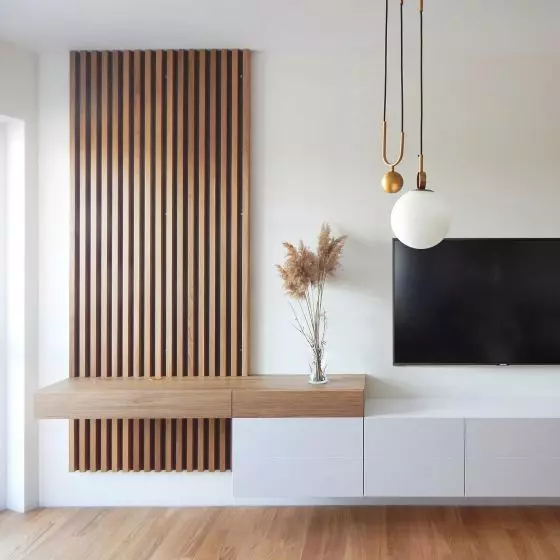The 19th century building of the former Pump Factory in Leszno has regained its luster, but has completely changed its function. In the post-industrial building, Jan Sikora of Sikora Wnętrza Architektura studio designed an industrial-style residential interior. The loft-like space is filled with original brick walls, concrete flooring, raw finishes and post-industrial-breaking accessories in warm tones and soft textures, and even a painting with a view of New York City, painted by the designer.
The 


building of the former Pump Factory in Leszno
Photo: Tom Kurek
Ola Kloc: What was the priority for investors?
Jan Sikora: The Forge is the beginning of the redevelopment of the old Pump Factory in Leszno. The investor - ICC Real Estate - gave us a free hand to show what a real loft looks like. But not the kind of softloft in a big slab with furniture made of plumbing pipes. So we created an uncompromising interior: we absolutely left the original brick walls, concrete floor, lintels and other raw elements. I categorically forbade the construction site to move any element or even dust without consultation. The result is exactly as I planned: an uncompromising interior based on stark contrasts.
The 


The winding steel staircase and columns emphasize the industrial character of the interior
photo: Tom Kurek
Ola: Lofts, due to their open space, materials used and raw finish, at first glance do not fit into the vision of a cozy apartment, through what elements did you decide to "domesticate" the space of the former factory?
Jan: The stronger the contrast, the easier it is, paradoxically, to "domesticate" a place. It's only when the rough is rough and the soft is really soft that the form becomes meaningful. Here my favorite example is the pyramid by Ming Pei in the courtyard of the Louvre. In Leszno, I added warming wood accents to the harshness of bricks and concrete in tones of warm browns, warming the interior. However, the real contrast and coziness was achieved through the soft greenery and warm upholstery of the furniture. Also, broken black in matte turned out to be a good frame - it cleanly creates contrast and a smooth frame for the raw walls and floor. Of course, the definition of home itself is very broad - for one person the space of staying and "settling in" will be a smartphone, for another a TV, and for a third a tent or pickup truck. One thing is certain: such spaces are not for everyone. Loft interiors are not a universal Scandinavian style, but "play with form for real."



matte finished black kitchen
photo: Tom Kurek
Ola: New interiors are often styled in the fashionable loft style, and how does the work in designing new and historic interiors differ?
Jan: New loft interiors - so called softloft - is work without a context in mind. It is based on quoting and building a storyline. The difference is like between non-fiction, such as a biography, and, say, a good detective story. In both cases we play on emotions, references and the final goal is a great space. For us, such a project was Garrison. A typical softloft, but is it worse? A matter of taste.
With projects based on the existing fabric, it is also important to listen to the "voice of the walls" (here I recommend the 1964 Venice Charter). You can't work with them without learning about the locality, the history of the place, but that's a topic for a separate conversation.



view from the kitchen to the living room
Photo: Tom Kurek
Ola: What was the biggest challenge, and what are you most satisfied with?
Jan: Personally, I'm most satisfied with the fact that I said at the beginning: no screw without my knowledge, because it's a sensitive matter. And I consistently guarded this until the end, even though my decisions (like leaving the walls raw) were controversial to say the least. I'm glad that I didn't break under the pressure of dozens of phone calls like "Mr. Janek, and this crystal lamp surely fits?", "Mr. Janek, and is this island made of beams a good idea?", "Mr. Janek, but how can you leave such raw walls - after all, it will be ugly!". The vision is one, there is one author, and you can either trust him, or there is a flop. I'm also pleased with the idea for the mezzanine - we non-invasively hung it in the middle section. The photographer Tom Kurek also did a great job - he was extremely involved in the project, he's a photographer of exceptional class, and I've had the pleasure of working with him for nearly ten years. Overall, I am pleased to have had the opportunity to work on such a project - I wish I had as many such authentic challenges and powerful design experiences as possible.
The 


ntresola non-invasively suspended is in the middle part of the loft
photo: Tom Kurek
Ola: The completed development is a show apartment, what are your plans for the other apartments created in the old factory building?
Jan: There is a lot of buzz about the investment, and we are just getting started in Leszno. We have already finished designs for another loft, developer's offices and staircases. Investors are also coming forward to buy lofts in this development and in the surrounding area. It is preparing to be a busy year of 2021 :)










































